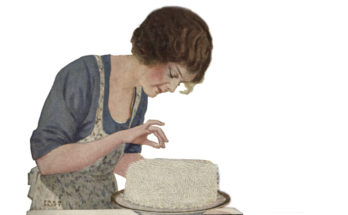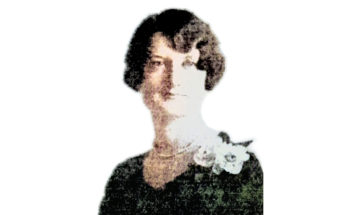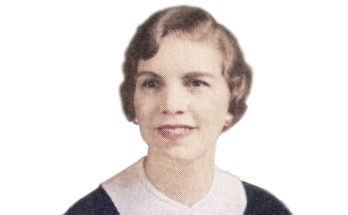Miss Parloa viewed life as made up of successes and failures. “Failures come not so much from the lack of capabilities and opportunities, as from the want of self reliance, industry and perseverance. Many persons start life well, but do not count the cost of making it a success, they are not willing to pay the price for it and then blame the world for not appreciating them. Constant change from one pursuit to another is a great hindrance to success. To succeed we must know our own powers; we must persevere. Fair weather never made a good sailor. Storms and gales give him experience worth having. A life without respect to God and his commandments will be a miserable failure.” —Maria Parloa, Maine Central Institute during Anniversary Week, June 19, 1871
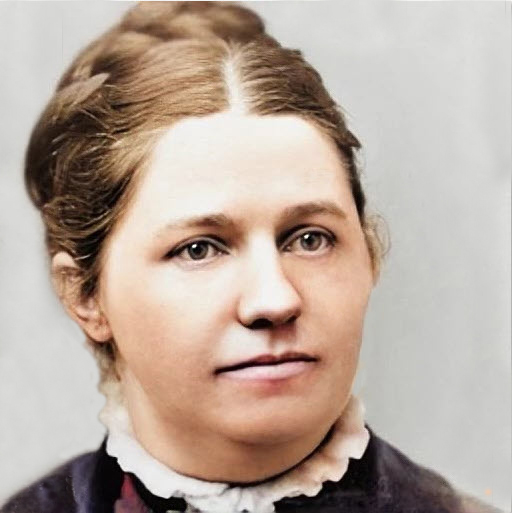
How did Maria Parloa transition from being an orphaned young domestic servant in a private home to becoming a culinary school graduate, professional baker, author of an acclaimed hardcover cookbook written while she was in school, and a pioneering owner of one of the first cooking schools in the United States? Her self reliance, industry and perseverance as she wrote in her school essay above, and perhaps her early influencer, Harriet Beecher Stowe, famous author of Uncle Tom’s Cabin, played an important part of her journey.
Parloa honed her skills as a skilled pastry chef in various New Hampshire hotel establishments, including Rockingham House in Portsmouth, the Pavilion in Wolfeboro, and the McMillan in North Conway. However, it was her time spent at the Appledorf hotel resort on a craggy island off the coast of Portsmouth, New Hampshire that proved to be the turning point for her. In her late 20s, Parloa became acquainted with remarkable women: Harriet Beecher Stowe, one of the most prominent figures of her time, and Celia Thaxter, whose family held ownership of the Appledore House. It was at this hotel that Parloa found inspiration for her first cookbook, as it was titled The Appledore Cook Book, written during her time at culinary school, and published in 1872. Maria formed a close acquaintance with a frequent guest of Appledore, Mrs. Stowe herself. This connection led Parloa to spend five winters under the behest of Mrs. Stowe, in one of the first winter get-a-way towns in Florida–Mandarin near Jacksonville. Here, she taught at Stowe’s small private school while still being employed summers as a pastry chef at New England resorts. By 1878, a year before the establishment of the renowned Boston Cooking School, Parloa had already opened her own cooking school. The school flourished under her guidance, attracting enthusiastic students from all walks of life ready to learn cooking. Such was her reputation that she even received requests to endorse at least one product that year, a testament to the regard in which she was held.
Parloa knowing Beecher-Stowe, author of Uncle Tom’s Cabin, and a powerful advocate for black rights and women’s rights, must have proved invaluable. An aside: Harriet and her older sister Catherine were leaders in the Home Economics movement. Catharine founded a school in the 1820s for girls to learn traditional subjects along with household arts and sciences, and Harriet taught there. Catharine’s life work was setting up schools for woman to teach children, and improve home life. Catharine wrote A Treatise on Domestic Economy for the Use of Young Ladies at Home and School in 1841, and The Domestic Receipt Book in 1846. Besides training teachers to teach children, she narrowed a focus to educate women teachers to teach children from unfortunate homes. Whereas Catharine was traditional, Harriet was for women’s suffrage. In 1848 Harriet helped organize the world’s first women’s rights convention, and in 1869 helped establish the National Woman Suffrage Association with Susan B. Anthony and Elizabeth Cady Stanton. Harriet’s father, Henry Ward Beecher, a famous firebrand anti-slavery speaker, was its first president. The same year, Catharine and Harriet co-authored The American Woman’s Home which was a thorough investigation of the household, proposing changes for efficiency with quite a bit of idealism.
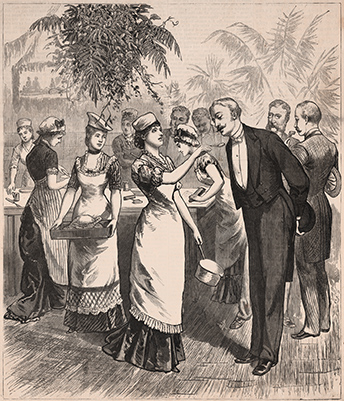
Upon the completion of one of her five winters spent in Mandarin, Florida, where she had been diligently teaching at “Stowe’s school” for African-American children, Maria Parloa embarked on a noble endeavor to raise funds for an organ for a church in Mandarin lead by the the Methodist Society. [The Episcopal Church of Our Saviour built by the Stowe family, hadn’t been built yet.] One newspaper article mentioned Parloa conducted these cooking classes in the coastal town of New London, Connecticut. Why did Parloa chose New London rather than in close proximity to the church in Mandarin, Florida? One could speculate that perhaps the church board members resided in New London during the winter months while enjoying the warmer climate of Mandarin. Another source, quoting Parloa herself, sheds further light on the matter, pointing us to imagine “South” being Florida, but of course Connecticut was also to the South of Boston! She recounted, “I was on a visit South, and, having been asked to deliver a lecture for a charity, I was puzzled for a subject. ‘Why not cookery?’ thought I; and cookery it was. This was so successful…” Together with her supportive friends, Parloa managed to raise nearly $100 for the Florida church.
It was during this time that Parloa discovered her natural talent for conducting cooking classes, finding great enjoyment in the process and recognizing its potential as a source of income. Eager to explore this newfound avenue, she decided to “test the waters” by delivering a series of cooking lectures at Boston’s renowned Tremont Temple, on the same street where she would house her school. Though she did not turn a profit from these talks, Parloa discovered a significant level of interest and enthusiasm among the attendees. Encouraged by these promising signs, she made the decision to establish her own cooking school, with the invaluable support of a board of women, likely including Mrs. Stowe and the women who served on the board of the Mandarin Florida church. This group had witnessed firsthand the immense benefit derived from Parloa’s previous fundraising efforts, thus instilling in them a firm belief in her abilities and potential for success.
Engaged in her role as a pastry chef at various hotels earlier in the year, Parloa made the move later in 1877 under the guidance of the esteemed “board of ladies,” and ventured to establish her very own private school, aptly named Miss Parloa’s School of Cookery. The school found its home on the upper floor of a commercial house on Tremont Street in the neighborhood of the Boston Common, possibly within view from the windows. Parloa’s classified advertisements in The Boston Daily and Evening Journals, spanning from January 1878 to March 1881, consistently indicated the school’s address as 171.5 Tremont St. in Boston. However, Wiki lists the address as 174 Tremont. Hence, certainty eludes us for now, and further research is being conducted to shed light on this matter. Yet, it is worth acknowledging that Parloa’s own advertisement carries a sense of dependability and reliability.
Visitors had to cut through the fine furnishings business called the “Household Art Rooms” to go upstairs to her school, making it an ever-intriguing walk with stained glass, etc. to reach Parloa’s tiny little parlor doubling as reception room. Doors were narrow with attractive curtains. Within the confines of the studio, there existed a mysterious dressing room, never mentioned but once, which one can surmise could have served as Parloa’s living quarters. This assumption gains support from details in the 1880 census, which indicate that this very space was, indeed, her home. Notably, Parloa shared this abode with two boarders, Sarah, 24, and Alley Read, 26, both of whom were aspiring cooking students. These sisters, born in Mandarin Florida, were classified as mulato in a census record, thus advancing Harriet Beecher-Stowe’s political and cultural goals, and reflecting their diverse heritage.
From the reception room a visitor walked up three steps to a light-filled room of large expanse with glass on part of the roof, and a large window on the the north side fitted up like a conservatory. Wonderfully huge rare, potted plants graced the main room and fern baskets hung grandly from the ceiling, see picture above.
The large studio had attractive blue and white tile behind the stove and kitchen sink. A scrupulously clean shelf held the cooking implements. There was one table near the stove, and the rest of the room held chairs for scheduled lectures, comfortably seating 70 people, but cramming a much larger number if necessary. The school proper enrolled four to six students in each class, seven days a week. The lectures, two and a half to three hours each were held two to three times per week; and there were scheduled weekly cooking lessons to benefit the poor, divided into three sessions for three age groups: girls, teens, and adult.
Besides her own school, Miss Parloa helped organize the newly-forming Boston Cooking School for 1879. She was also their guest lecturer when they opened, but her fees proved too high for them to sustain, leading them to explore other options. With a better-located address overlooking the Boston Common, The Boston Cooking School flourished, and was the first cooking school to be incorporated. Today, people remembered Parloa’s new neighbors as the Boston cooking school in the 1800s, lasting from 1879 to 1902-3, and made more famous under Fannie Merritt Farmer’s leadership.
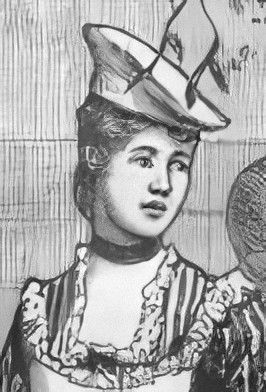
Unfazed by any setbacks, Parloa persevered with her esteemed establishment, Miss Parloa’s School of Cookery. A momentous occasion occurred when her “Boston cooking school” graced the front cover of Frank Leslie’s Illustrated Newspaper in 1880, undoubtedly a pinnacle of publicity for her school. While the recognition was undoubtedly cherished, it may not have been without its imperfections. The newspaper’s front page referred to her school as the Boston cooking school, potentially causing confusion due to the existence of the institution bearing that name, which was gaining traction and support from other prominent women and an increasing number of students. However, those who continued on to the inner pages of Frank Leslie’s newspaper would discover that it was, in fact, Miss Parloa’s School of Cookery being celebrated. The article painted a celestial picture of the school and its proprietor, with effusive praise and compliments. Yet, one piece of minutia in the high-profile article could have been taken out of context. She was candid that her previous teaching experience had been drudgery. Given the context it was innocent, but her financial backers served on the board of the Florida church associated with the teaching position she was referring to at Mrs. Stowe’s school.
Within a year, observing the advertisements in 1881, she maintained an unwavering commitment to her culinary school, finding time to train not only society ladies from Boston and neighboring cities, but also impoverished girls, teenagers, and adult women all with their own classes on a weekly basis. Furthermore, she embarked on travels to deliver lectures and conduct cooking series, all while juggling her demanding business endeavors.
Notably, she said one of her most appreciative audiences was found at the Cooper Union School in New York City. Following a successful honeymoon period of four to five years in Boston, Parloa made the decision to close her school in 1882, subsequently opening another cooking school in New York City that same year.
Besides her knowledgeable, entertaining, and unflustered cooking demonstrations at the school, and as a traveling instructor, she authored numerous books and booklets.
Through the eyes of history, as early as the 1910s, Harriet Beecher-Stowe and Maria Parloa were both on the short list of prominent early influencers in the Home Economics movement. The other prominent influencers were Ellen Richards, Juliet Corson, Anna Barrows and Mrs. Rorer. Of course there were many more, but these were the names remembered in a 1915 woman’s club essay and newspaper article. If Beecher supported or encouraged Parloa to open one of the earliest cooking schools in Boston, it would be in line with Beecher’s outlook and previous efforts.
Continuing with her life in a timeline–
Timeline: Maria Parloa (September 25, 1843 – August 21, 1909)
1843 – 1859 raised in New England, probably under guardianship. A few common theories: she was an Irish immigrant, product of the potato famine; she was orphaned early; she was running from someone; she was born out of wedlock in the states–she did mention she was born in Massachusetts (but also other places, depending on the year). History mysteries.
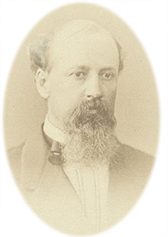
1860 “Maria Parlo” was a domestic servant in the house of Gustavus V. Fox, 39, agent for Bay State Mills in Lawrence, a woolen company, and his wife, Virginia L. Fox, 37, 11 Jackson Ct Lawrence Mass., Maria was 16, listed as born in Ireland, as was the other domestic servant, Margaret Leary, 24. Gustavus had just married Virginia Woodbury in Portsmouth, NH in 1855 and had their wedding dinner at the Tremont House [next to Tremont Temple where decades later, Maria Parloa held her first for-pay cooking classes.] Gustavus retired from being in the Navy in 1856. It is possible that this Maria Parlo was in his household as early as then, but there are no records of proof. She would have left his household the very next year, 1861, as Gustavus Fox and Virginia moved to Washington DC. If domestic servants were good, many families of the time would bring their cooks with them when they moved. There is a chance that “Maria Parlo” moved with the family to DC. I’ve seen no hint of this in Maria Parloa’s life, if it is her, but it’s worth being open to it as we have no record of where she was in 1861. Interestingly, having to do with possible Maria Parloa as the family’s chef, Gustavus was a gourmet “fond of rich dinners,” [mrlincolnswhitehouse.org] well known for his knowledge of exotic beverages and unusual dishes. Background: Gustavus had been a Navy officer midshipman since 1838. He began as a midshipman on the Saratoga, a war sloop built and launched in Portsmouth NH the year before Maria’s birth [spelling it out: looking at every possibility, I am researching to prove or disprove that Gustavus Fox was involved in an indiscretion before going out to sea in 1843, and became Maria’s father] but beginning in 1850 he spent more time on land, usually in Dracut, Massachusetts with his parents unless he was working commercial ships. Gustavus and Virginia L. Fox have a long tie to Portsmouth, NH. Besides being married there, Virginia supported a hospital there since it’s inception. After Gustavus death she donated enough to have them name the Portsmouth NH hospital after him. This involvement with Portsmouth creates a possible lead that maybe the Foxes introduced their chef “Maria Parlo” to the Appledore hotel, as it is the island directly off of Portsmouth. Gustavus Fox moved to DC at the beginning of the Civil War as he volunteered his services, and he was appointed the first Assistant Secretary of the Navy. President Lincoln famously said to Harriet Beecher Stowe, ‘So you’re the little woman who wrote the book that made this great war!’ However, the Civil War officially began with the capture of Fort Sumter in South Carolina. Gustavas Fox’s first task was to help stop the conflict at sea.
1860s Worked at hotels in New England as a pastry chef, including Appledore House by 1869. Speculation: did the owners of Appledore House help with Parloa’s tuition the next year, possibly in exchange for her writing their cookbook?
1871 28 years old. Parloa entered the Normal School of the Maine Central Institute, Pittsfield, Maine. Fittingly, she was an essayist during 1871 Anniversary week at the school and read her essay Success and Failure [top paragraph] in front of a large audience. Considering she may have worked for Gustavus Fox, her above words to the audience bring a new resonance, “Fair weather never made a good sailor. Storms and gales give him experience worth having.” She remembered Maine Central Institute in her last will.
1872 29 years old. Authored The Appledore Cook Book while she was enrolled at Maine Central Institute.
1873 Graduated Maine Central Institute.
1873-1877 winters. Teacher in “a small country school” Jacksonville, FL owned by Harriet Beecher Stowe. Taught a cooking class as a Sunday school fundraiser for a church where Mr. Stowe used to preach, and became motivated to teach cooking professionally.
1876, summer. First cooking lecture after Florida fundraiser success. “Cooking and Digestion” lecture was
held in New London, Connecticut, or Mandarin, Florida–theories differ.
1877 She gave a successful series of four talks in one of the lecture rooms at Boston’s Tremont Temple, and in the summer worked in the “Pastry Dept.” of the Pavilion Hotel Wolfeboro NH.
1877 June 18: “Miss Parloa is lecturing on culinary art, and establishing classes in cookery in Massachusetts.”
1877 October. Maria was 34 years old. Opened Miss Parloa’s School of Cooking in Boston. She contemplates that after the school seasons, she spend the summers in Maine.
1878 Camp Cookery, author. She also gave an endorsement of Burnett Flavoring Extract in newspaper advertisement. Was this her first endorsement?
1878, summer. Visited London’s National Training School for Cookery and the Boards Schools there; also visited France to learn French cooking. [where?] One article also mentioned a visit to Germany.
1879 First Principles of Household Management, author. [digitalcommonwealth] Her book was written as a cooking school textbook. This was the year the Boston Cooking School began, and she was an important founding teacher there, helping to develop the school’s program.
1879 Lecturer at Chicago branch of the Chautauqua Summer School.
1880 Maria was 37 years old. Miss Parloa’s New Cook Book: A Guide to Marketing and Cooking, author. Continuation of being a teacher of cookery, living at 171.5 Tremont St Boston with boarders Sarah, 24, and Alley Read, 26, both of Florida who were [her] students of cookery. These young women were most undoubtedly from Mandarin, Florida, where Harriet Beecher-Stowe wintered, and Parloa used to work. [Mary (Alley) Read later married Loammi H. Tallman born 1842 of NY, and in 1900 was seamstress in Jacksonville, FL]
1880 Lecturer at Chicago branch of the Chautauqua Summer School
1880 Parloa begins 2.5 hour classes every Saturday at Lasell Seminary in Auburndale, Mass. 11 classes, ending May 1, 1880.
1881 Parloa continues her 2.5 hour classes every Saturday at Lasell Seminary in Auburndale, Mass. 11 classes, ending May 1, 1881.
1881, March. Parloa still recognized in Chicago as leader in cooking in Boston, as they finally found their own cooking teacher, Mrs. Emma P. Ewing. Also acknowledged was Miss Juliette Corson in NYC, and Miss Rorer in Philadelphia.
1881, Friday, April 15 Lecture at Insurance Hall [Main St. in Worcester.] demonstrating Bread making.
1881 Lecturer at Chicago branch of the Chautauqua Summer School
1881 Oct 31 Parloa began a series of lectures at Hershey Hall in Chicago. First she read all seven recipes as students took notes, and then she demonstrated the making of them. The stage kitchen was comprised of two white covered tables of the same size, an ordinary size gas range. A younger female helper occasionally brought materials to her for the demonstrations from a side entrance. Miss Parloa followed the directions the class gives from their notes, this being a useful learning method.
1882 Jan 19 Addressed the Illinois Social Science Association, Committee on Domestic Economy in Chicago.
1882 Feb 27 to March 21 Parloa began a course of eight demonstration lectures to about 50 women at the New York Cooking School, 22 E. 17t St, NYC a school founded and run by Juliet Corson. Parloa stood upon a raised platform behind cooking utensils she would use upon the kitchen table. At her right was a small cooking stove. She explained the scope of the work and invited the people to ask questions during the demonstration. She dictated and people wrote in their notebooks one recipe at a time before demonstrating it. During the lecture she gave the reason for everything she did and answered questions. Gone was the 1881 Oct 31st method of call-and-response teaching.
1882 March 28 Lecture at Demonstration Hall of the College of Pharmacy at 23rd St and 3rd Ave, NYC. She lectured on marketing [selecting meats when shopping] as a butcher took his cues from her, and helped educate on the cutting of an ox. The audience consisted of about one hundred women and four men.
1882 Maria Parloa closed Miss Parloa’s School of Cookery in Boston, and in November opened Miss Parloa’s School of Cooking at 222 East 17th St. in New York City. Strangely, Juliet Corson established the first NYC cooking school at 22 E. 17t St. The addresses are so close, it needs to be confirmed. Otherwise, Parloa set up her school on the same street. That was a common practices given the example of her school on Tremont street in Boston and the Tremont street Boston Cooking School.
1884 Nov 12 two and a half hour plus lecture at Temperance Hall under the management of Caterer Hill. A black man and girl assisted.
1883-1887 For five more works published between 1883 and 1887, see our post just for Maria Parloa’s books and booklets.*
1890 She lived at 2 Wayne Street, Boston, in census listed as teacher of cooking. [Was she going back and forth living in either Boston and New York? interesting.]
1893-1900 For three more works published between 1893 and 1900, see our post just for Maria Parloa’s books and booklets.* In 1893 she wrote the preface to a book while in Roxbury, Mass.
1894 Visited France.
1900 56 years old. Lived in New York City at 204 West 83rd Street with servant Sarah Hourigan, 27. The census taker wrote Maria Parloa’s work as “Author-Domestic Service.”
1905-1909 For four more works published between 1905 and 1909, see our post just for *Maria Parloa’s books and booklets.
1909 She died at her home at 43 East Bethel, Connecticut, about a month before her 66th birthday.
